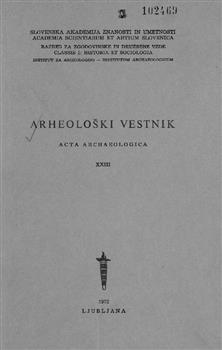Brinjeva gora Near Slovenske Konjice, Excavation 1953
Abstract
The earliest proof of a settlement on Brinjeva gora is the presence of Litzen pottery.75 We must presuppose a Middle Bronze Age settlement because of the existence of a mound with skeleton graves from Brezje below Brinjeva gora, which S. Pahič, on the basis of needles found, dated to Bronze Age B-l76 according to Willvonseder. Several pottery fragments from the village, predominantly a small pot with a wart on the widest part of the circumference, 77 are proof of settlement at this time, according to S. Pahič.78 On the basis of village pottery excavated in 1953 it is obvious that the village enjoyed its greatest period of growth in Ha A-B. If the settlement in Ha A kept more to the edge of the ridge, then the village in Ha B covered all the upper slope.79 By the end of Ha B however, the settlement had almost ceased to exist. That it was not completely deserted is borne out by modest finds from the Early Iron Age, such as a boat-shaped fibula72 and some pottery fragments. Late La-Tène graphite-covered pottery, decorated with brush ornamentation, indicates that the settlement revived in the late La-Tène period, but did not achieve such an expansion as in Ha A-B. We have no tangible proof for settlement in the early classical period, but Brinjeva gora appears again finally as a fairly thriving village in the late Roman period.
Downloads
Downloads
Published
How to Cite
Issue
Section
License

This work is licensed under a Creative Commons Attribution-NonCommercial-ShareAlike 4.0 International License.
Authors guarantee that the work is their own original creation and does not infringe any statutory or common-law copyright or any proprietary right of any third party. In case of claims by third parties, authors commit their self to defend the interests of the publisher, and shall cover any potential costs.
More in: Submission chapter





